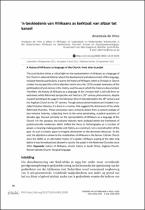| dc.contributor.author | de Vries, Anastasia | |
| dc.date.accessioned | 2023-04-18T09:50:20Z | |
| dc.date.available | 2023-04-18T09:50:20Z | |
| dc.date.issued | 2022 | |
| dc.identifier.citation | de Vries, A. (2022). ’n Geskiedenis van Afrikaans as kerktaal: Van altaar tot kansel. Tydskrif vir Letterkunde, 59(3), 96-112. http://dx.doi.org/10.17159/TL.V59I3.12301 | en_US |
| dc.identifier.issn | 2309-9070 | |
| dc.identifier.uri | http://dx.doi.org/10.17159/TL.V59I3.12301 | |
| dc.identifier.uri | http://hdl.handle.net/10566/8831 | |
| dc.description.abstract | This contribution shines a critical light on the representation of Afrikaans as a language of
the Church in external histories about the development and advancement of the language,
inclusive histories particularly. It seems the history of Afrikaans within a Christian or Church
context has escaped the critical attention which since the 1970s created awareness of the
politicisation of and silences in the history, and the way in which the history is documented.
Therefore, the history of Afrikaans as a language of the Christian faith is still told from an
exclusively white Reformed perspective and held as a 20th century phenomenon, despite
research pointing to its usage in the Moravian Church (Genadendal) in the 18th century and
the Anglican Church in the 19th century. Though various denominations are included in socalled inclusive histories, it is done in a manner that suggests the dominance of the white
Reformed Churches. | en_US |
| dc.language.iso | en | en_US |
| dc.publisher | University of Pretoria | en_US |
| dc.subject | Religion | en_US |
| dc.subject | Language | en_US |
| dc.subject | South Africa | en_US |
| dc.subject | Race | en_US |
| dc.subject | Afrikaans | en_US |
| dc.title | ’n Geskiedenis van Afrikaans as kerktaal: Van altaar tot kansel | en_US |
| dc.type | Article | en_US |

